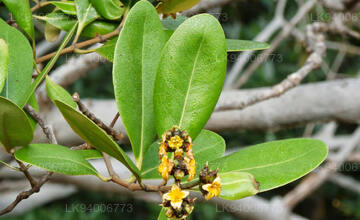Avicennia officinalis; Motamunda; මොටමුණ්ඩ
Avicennia officinalis is a species of mangrove also known as the Indian mangrove. It is named after the famous Iranian scientist Ibn Sina. The young tree forms a low, dense bushy crown. When it matures, it forms a columnar tree up to 15 m and may grow up to 30 m. The shiny green leaves, 10 cm long by 5 cm wide, have rounded apexes and golden-brown underleaf and grow in opposites. The flower, the largest among the Avicennia species has a diameter of 6 to 10 mm when expanded. It is orange-yellow to lemon yellow in color. The bark is smooth, dirty green to dark gray in color. It is slightly fissured and does not flake. The fruit is green or brown, heart-shaped abruptly narrowed to a short beak, is 2.5 cm long or more.
Avicennia officinalis is found sporadically on the banks of rivers and rarely found near the sea. It prefers clay soil and is usually found inland. The plant can be found in Iran, Bangladesh, Brunei, Cambodia, India, Indonesia, Malaysia, Myanmar, Papua New Guinea, the Philippines, Singapore, Sri Lanka, Thailand, and Vietnam.
Uses:
Fruit is edible. The wood can be used as firewood. sap can be used as a contraceptive material.










